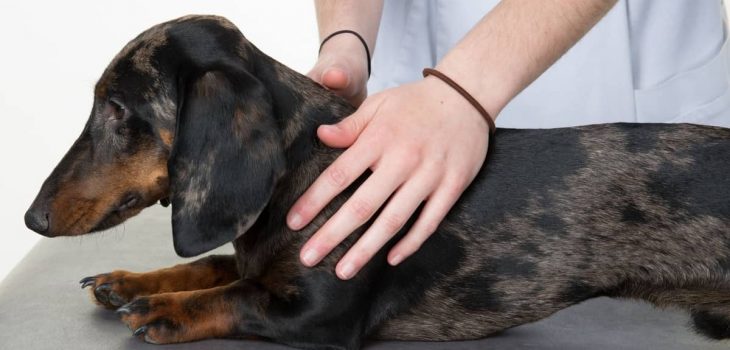Back issues are a common worry for Doxie owners. Hopefully, you’ll avoid the issue altogether but if you don’t, here’s what you need to know about dog spinal surgery recovery time – what to expect and what to do.
Every trauma is different, as is every surgery, and the recovery time of every dog. Some dogs are unfortunate to never be able to walk again, while the worst cases can even have a lethal outcome. However, thanks to the wonders of modern veterinary medicine and surgery techniques, the vast majority of dog back surgery cases end positively and the dogs learn to walk again after recovering.
What Is The Standard Dog Spinal Surgery Recovery Time?
Intervertebral Disc Disease (IVDD) is a very nasty condition that a lot of dachshunds as well as beagles, Shih Tzus. Pekingese dogs, cocker spaniels, and basset hounds suffer from. The normal post-op dog back surgery recovery time can vary depending on how bad the injury was. The three main factors that play into this are:
- How long was the spinal cord compressed
- The amount of damage suffered by the spinal cord
- How fast did the material from the extruded disk hit the spinal cord
Based on these three variables, the recovery time can range anywhere between 10 days and 3 months. According to a 2015 Hady & Schwarz study posted in the Journal of Veterinary Medicine and Animal Health, the average recovery time for Dachshunds with IVDD to start walking again was 16 days but dogs still spent an average of 40 days informal physical rehabilitation.
Then, there’s the 2002 Davies & Brown study posted Wiley Online Library according to which 96% of all post-op dogs were able to start walking again after 3 months at most. This is a very high percentage, especially considering that the study was made decades ago. According to it, the average time before dogs could start walking again was 12.9 days. And, for dogs lucky enough to have had postoperative voluntary motor function the time was even shorter – 7.9 days on average.
Many other studies have yielded similar findings too. Most show that 90+% of dogs start walking somewhere between 10 and 13 days after the operation. However, it’s worth noting that the dogs with the fastest and easiest recovery also had lower pre-op Pain Response Scores. If your dog is higher on this scale, you can expect a slower than average recovery time.
When looking at full recovery and not just the point of your dog starting to walk again, most studies suggest an average of ~44 days.
How To Improve The Dog Spinal Surgery Recovery Time?
Looking after a dog with back problems can be difficult but isn’t unmanageable as long as you love your pet and are willing to help it recover. When it comes to helping with the dog spinal surgery recovery time, the first and main tip is to always follow every word of your vet’s instructions.
If anything you read here or elsewhere on the internet contradicts your vet’s advice, disregard what you’ve read and follow your vet’s instructions. Your vet is the one who knows your dog personally and is aware of its specific and individual needs. Everything we mention here are just general tips and practices that apply to most cases but may not be 100% what your dog needs.
With that in mind, here’s what post-op dog back surgery recovery typically involves:
Formal Rehabilitation
The exact type of physical therapy and rehabilitation your dog is going to need can vary on a case-by-case basis. In many cases, you should be able to do some of the stuff at home after your vet and/or physical therapist shows you how things are done. Even in the lighter cases, however, skipping physical therapy is definitely not recommended. If you are going to do most of it at home, that should be done only after extensive consultation with a specialist.
Most forms of dog back physical therapy and rehabilitation include a combination of the following procedures:
- Laser therapy
- Acupuncture
- Electrical muscle stimulation
- Range of motion exercises
- Sitting to standing exercises
- Stretching exercises
- Poles and obstacle courses
- Treadmills
- Therapeutic swimming
- Massages and more

Learn more about: Quick Guide To The Main Piebald Dachshund Health Problems
As you can see, while some of these can be done at home, others definitely require professional assistance and visits to a rehabilitation center.
Dog Confinement
If you don’t have a dog crate, you’d do well to get one for your dog’s post-op recovery. A well-sized crate can seem cruel at first but it’s important as it prevents the dog from hurting itself. The crate should be just big enough for your dog to lie in comfortably. However, it should be small enough to prevent unnecessary movements.
You’ll need to fill the crate with a nice and soft bedding and you’ll have to change or wash it daily. You’ll also want to turn the dog manually from time to time, as well as perform some of the rehabilitation procedures such as massages inside the crate.
Your dog should remain confined there for about a month on average, barring any going out for physical therapy.
Help With Urination
As your dog won’t be able to walk for a bit (or will at least have difficulties doing so) you may need to help express its bladder and not just clean after it. This help includes softly pushing the dog’s lower abdomen while firmly supporting the rest of its body. Your vet may give you a muscle relaxant to further help if there are any bladder issues. If you can’t help your dog express its bladder you should seek veterinary assistance immediately as your dog’s bladder can’t remain full for long.
Medications, wound maintenance, diet change, and more
Your vet will prescribe you the appropriate medications, diet changes, and supplements your dog will need. Keeping an eye on the wound and making sure it’s always clean and uninfected is also a must.
Home Remodeling
You should also take the time of your dog recovering to remodel your home a bit. If your dog used to like jumping on the bed, sofa, chairs, or other places, you should make them easily accessible from now on. An easy way to do this is to add small ramps. This will allow your dog to easily walk up and down on without having to jump. Alternatively, some higher spaces can just be made inaccessible to avoid accidents.
In Conclusion – Dog Spinal Surgery Recovery Time and Odds
Back surgery is a very nasty thing but it’s not unmanageable. With enough time, resources, and care, over 90% of dogs can get over this issue. Unfortunately, the whole procedure and process are quite expensive too. That’s why it’s best to try and avoid the problem altogether with proper care throughout your dog’s life. Pet insurance policies can also help with the expenses if you’ve set one up ahead of time.




